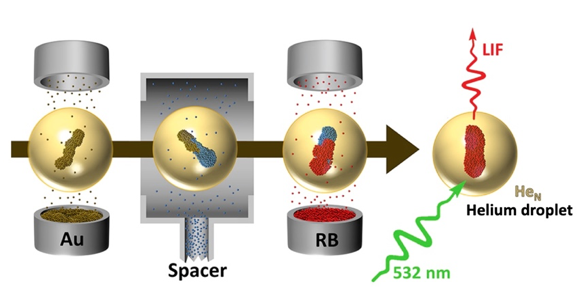Fluorescence Quenching and Enhancement in Rhodamine B Covered Au Nanoparticles in Helium Nanodroplets
Nanoparticles comprising three different materials in a core@shell@shell structure are synthesized in cold helium droplets by sequential doping. [1,2]
Rhodamine B (RB) molecules form complexes in helium droplets that give rise to a strong fluorescence signal upon laser excitation at 532 nm, which enables an in-situ investigation of the synthesized structures. In the presence of Au core particles, the fluorescence collected from RB molecules is quenched, explained by an excitation transfer from excited molecules to the Au particles. This observation also indicates that both dopants are in contact and two-component Au@RB particles are formed. If an additional doping material is added to the helium droplets between the Au and RB pickup regions, the fluorescence is recovering again. This demonstrates that the added dopants form a spacer layer that separates the Au core from the RB molecules. Furthermore, it has been found that the fluorescence is recovered independent of the spacer material, Ar, isopropyl alcohol and hexane have been used, all of which are solid in the cold liquid helium environment. The synthesis process is sketched in the Figure.
The results demonstrate that it is possible to form nanoparticles consisting of three different layers in a Au@shell@RB configuration with the helium droplet synthesis technique.[1] Our current efforts are geared towards the spectroscopic characterization of other material combinations, focusing on helium droplets that contain plasmonic metals as major constituent.

[1] Roman Messner, Wolfgang E. Ernst and Florian Lackner, J. Phys. Chem. Lett. 2021, 12, 145-150
[2] Wolfgang E. Ernst and Andreas W. Hauser, Phys. Chem. Chem. Phys., 2021, 23, 7553-7574